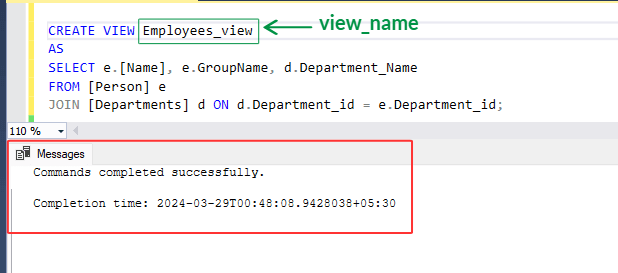Text copied!
SQL Views
In SQL, Views are like saved queries result that act as virtual tables, It's not an actual table but a saved query result that you can treat as if it were a table.
Views help you organize and simplify your data, making it easier to work with and control who sees what.
Here's the basic syntax for creating a view in SQL :
CREATE VIEW view_name
AS
SELECT column1, column2, column3, ...
FROM table_name;
• CREATE VIEW : This keyword is used to indicate that you're creating a new view.
• view_name : This is the name you want to give to your view.
• AS : This keyword is used to specify that you're defining the structure of the view.
• After the "AS" keyword, we specify the SELECT statement.
Here's an example of creating a simple view in SQL :
1. Let's assume you have a database with two tables : [i]. Person [ii]. Departments

2. Now, let's create a view that combines data from both tables to show the names, group names of [person] along with their respective department names from [Departments] table:
3. Please run the following SQL statement :
CREATE VIEW Employees_view
AS
SELECT e.[Name], e.GroupName, d.Department_Name
FROM [Person] e
JOIN [Departments] d ON d.Department_id = e.Department_id;

4. In above statement, We're creating a view called "EmployeeDepartmentView". The view combines data from the employees and departments tables by joining them on the department_id column. It includes the employee's name (e.name), salary (e.salary), and department name (d.name).
Selecting View :
5. Now, you can query this view as if it were a table.
SELECT * FROM Employees_view;

6. Above query returns a result set showing each person's name, group_name, and the department they belong to, without having to join the tables every time.
Deleting View :
7. To drop (delete) a view in SQL, run below SQL statement.
DROP VIEW Employees_view;

8. After executing above statement, the "Employees_view" view will be deleted from the database, and you won't be able to query it anymore.
Great job! You've successfully created, selected, and deleted views in SQL!